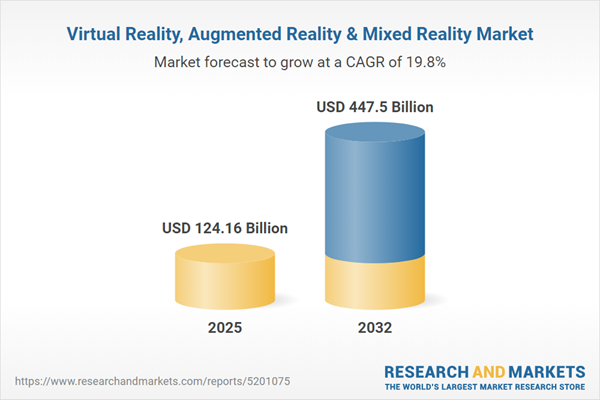Speak directly to the analyst to clarify any post sales queries you may have.
Immersive technology is redefining organizational agility, enabling enterprises to accelerate digital transformation, streamline operations, and quickly address shifting market demands. Senior decision-makers now view immersive platforms as essential assets for structured innovation and sustainable enterprise growth.
Market Snapshot: Virtual Reality, Augmented Reality & Mixed Reality Market
The global immersive technology market is advancing rapidly, with adoption accelerating across manufacturing, healthcare, and education. Virtual reality, augmented reality, and mixed reality now support diverse use cases, from workforce development to operational efficiency improvements. Hardware and software innovations are simplifying complex workflows, helping organizations remain agile. Digital integration is becoming critical for maintaining competitiveness as industries transition towards technology-driven environments.
Scope & Segmentation of the Immersive Technology Market
- Technology Types: Location-based augmented reality, marker-based AR, markerless AR, projection-based platforms, immersive and non-immersive virtual reality, and mixed reality systems that merge physical and digital environments.
- Component Categories: Hardware such as sensors, advanced displays, projectors, cameras, and accessories; software platforms; and a wide range of services including consultation, integration, deployment, maintenance, and content management to build robust ecosystems.
- Device Types: Handheld devices, head-mounted displays, and heads-up displays tailored to support enterprise fieldwork, remote collaboration, and advanced immersive experiences across industries.
- Device Categories: Wired and wireless options support mobile or stationary deployments, giving organizations flexibility to fit operational requirements and site conditions.
- Applications: Workforce skill development, interactive learning, industrial process optimization, healthcare delivery, real estate showcasing, modern entertainment, and e-commerce experiences designed for higher engagement and productivity.
- End-Users: Commercial enterprises, the public sector, and consumer-focused organizations utilize immersive solutions to enhance efficiency, upskill personnel, and improve engagement among stakeholders.
- Regions Covered: The market is segmented into the Americas, Europe, the Middle East, Africa, and Asia-Pacific, each influenced by unique regulatory requirements, manufacturing landscapes, and technology adoption patterns.
- Leading Companies Assessed: The report includes analysis of Apple Inc., Baidu, Carl Zeiss AG, CitrusBits Inc., Goertek Inc., Google LLC, HiSilicon, HP Inc., HTC Corporation, Immersion Corporation, Lenovo, Magic Leap, Meta Platforms, Microsoft, Niantic, Nvidia, PICO Immersive, Qualcomm Technologies, Samsung Electronics, Seiko Epson, Sharp Corporation, Snap Inc., Sony Group, Ultraleap Limited, Unity Software, Valve Corporation, VR Owl BV, Owl VR Solutions, Vrgineers, Vuzix Corporation, and Xiaomi.
Key Takeaways for Senior Decision-Makers
- Enterprise adoption of immersive technology supports scalable transformation, increasing organizational resilience and the ability to adapt to evolving workflows.
- Collaboration between hardware developers, software vendors, and connectivity partners is essential for seamless implementations and integration with legacy systems.
- Approaches to immersive technology vary globally, as North America emphasizes software advancement, EMEA navigates regulatory complexities, and Asia-Pacific leverages its manufacturing ecosystem for market leadership.
- Diversifying sourcing and supply chains enhances an organization's agility in responding to shifts in regulatory or operational environments worldwide.
- Investing in artificial intelligence and custom software development accelerates the evolution of immersive platforms and drives continued technology adoption across industries.
Tariff Impact on Adoption and Cost Dynamics
Recent changes in U.S. tariffs have driven manufacturers to expand their sourcing strategies and diversify production locations. As a result, enterprises gain broader access to immersive technology, while software vendors adapt with region-specific pricing and compliance solutions. These adjustments help maintain business resilience and support continuity as global trade regimes evolve.
Methodology & Data Sources
This analysis integrates secondary research, expert interviews, and in-depth evaluation of emerging trends. Each data point is rigorously validated, ensuring senior leaders access reliable and actionable insights for immersive technology investments.
Why This Report Matters
- Presents targeted recommendations to guide immersive technology implementations in line with ongoing digital transformation objectives.
- Supports proactive risk management and effective resource allocation as organizations navigate complex regulatory and operational landscapes.
- Enables enterprise leaders to build technology resilience and drive innovation within evolving digital business models for long-term competitive advantage.
Conclusion
This report provides decision-makers with the knowledge required to make informed investments in immersive technology, reinforcing enterprise adaptability and supporting strategic growth as market conditions evolve.
Additional Product Information:
- Purchase of this report includes 1 year online access with quarterly updates.
- This report can be updated on request. Please contact our Customer Experience team using the Ask a Question widget on our website.
Table of Contents
3. Executive Summary
4. Market Overview
7. Cumulative Impact of Artificial Intelligence 2025
Companies Mentioned
The companies profiled in this Virtual Reality, Augmented Reality & Mixed Reality market report include:- Apple Inc.
- Baidu, Inc.
- Carl Zeiss AG
- CitrusBits Inc.
- Goertek Inc.
- Google LLC by Alphabet Inc.
- HiSilicon (Shanghai) Technologies Co., Ltd.
- HP Inc.
- HTC Corporation
- Immersion Corporation
- Lenovo Group Limited
- Magic Leap, Inc.
- Meta Platforms, Inc.
- Microsoft Corporation
- Niantic, Inc.
- Nvidia Corporation
- PICO Immersive Pte.ltd.
- Qualcomm Technologies, Inc.
- Samsung Electronics Co., Ltd.
- Seiko Epson Corporation
- Sharp Corporation
- Snap Inc.
- Sony Group Corporation
- Ultraleap Limited
- Unity Software Inc.
- Valve Corporation
- VR Owl BV and Owl VR Solutions GmbH
- Vrgineers, Inc.
- Vuzix Corporation
- Xiaomi Corporation
Table Information
| Report Attribute | Details |
|---|---|
| No. of Pages | 187 |
| Published | November 2025 |
| Forecast Period | 2025 - 2032 |
| Estimated Market Value ( USD | $ 124.16 Billion |
| Forecasted Market Value ( USD | $ 447.5 Billion |
| Compound Annual Growth Rate | 19.7% |
| Regions Covered | Global |
| No. of Companies Mentioned | 30 |









